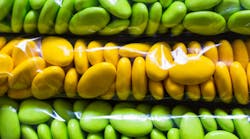Recyclable. Recycled content. Compostable. Monolayer. Paper. Corn-based.
Candy/confectionery processors who are interested in sustainable packaging film have so many options that they might feel like a kid in a ... well, you know.
Except that putting sweet goods in sustainable packaging is not all sweetness. It often entails tradeoffs in factors like expense, product protection and line speeds.
Candy/confectionery, as a segment, is well suited to sustainable initiatives. It’s often sold in single-serve sizes, which makes the packaging especially liable to turn up as visible litter. And its consumers are disproportionately young and thus more likely to let environmental concerns influence their purchasing.
The major candy companies have announced sustainable packaging initiatives, all of them pledging a reduction in virgin plastic use and other goals. Mars Wrigley and Ferrara have both promised that all of their packaging will be 100% sustainable by 2025; Hershey has the same goal for 2030.
But what does it mean for packaging film to be sustainable? To understand that, it helps to look at why standard packaging film is so unsustainable.
Candy, whether it’s bagged or individually wrapped, is usually packaged in multilayered film. The inner layer serves as the sealant, sticking to itself when pressed by hot or cold jaws of a flowrapper or bagger. The outer layer bears the products graphics. Both layers have to protect against moisture (a big issue with sugary products) and oxygen.
This setup protects the product well, but presents sustainability issues. The biggest problem is that the different layers usually are made from incompatible polymers. The inner sealant layer is usually polyethylene, while the outer one is polypropylene, nylon, polyester or another material. The chemical difference between these polymers makes film that incorporates them nearly impossible to recycle. This comes on top of the normal difficulty involved in recycling flexible film, which most recycling centers don’t have the proper equipment to handle.
Making the film all from a single polymer is a way to get around the compatibility problem, which is why such films are usually marketed as “recyclable.” These can be monolayer films, or they can have layers of the same kind of polymer, but with different functionality.
An example of the latter is made by ProAmpac. This film uses polyethylene for both the inner sealant layer and the outer layer; but the inner layer is designed to melt and seal, and the outer layer provides stiffness and a suitable print surface. The inner layer has been structured to provide the necessary oxygen barrier, which ordinarily would be a problem with polyethylene, says Nathan Klettlinger, ProAmpac’s director of global marketing. The film performs as well as many conventional multi-polymer films in protecting the product, he says, and in many cases, runs at the same rates on filling machines.
“As with any structure change, there’s always tradeoffs, but we’ve been able to get very, very close to conventional laminates, and the benefit is recyclability,” Klettlinger says.
Hershey Co. has found those tradeoffs to be the biggest challenge for using single-polymer films, says Jeff King, senior director of global sustainability & social impact.
“The largest challenges are in manufacturing, product and consumer function,” King says. “Our current materials have been curated for high-speed conversion and have been optimized over years to deliver barrier, print and consumer functionality, which is limited when using single-material structures.”
Mars Wrigley has taken some steps toward mono-polymer material with a couple of its overseas packages: a mono-polymer pouch for M&Ms in France and a paper-based flow wrap for its Balisto bar in Germany.
Mars Wrigley plans to roll out compostable packaging for Skittles no later than early next year.
Second-life plastic
Another major alternative for sustainability in film comes through recycled content. It’s hard or impossible to find film with 100% post-consumer recycled (PCR) content, but alternatives are available with a guaranteed percentage. ProAmpac, for instance, offers bag material made with 25% PCR. It has furnished this material to Justin’s LLC, a gourmet nut-butter unit of Hormel, to package their nut-butter-covered nuts.
PCR film has the same basic problem as any other packaging made from recycled content: There’s not enough recycled content out there. The U.S. recycling rate is just not high enough to furnish all the PCR resin that CPG companies want, especially to make bottles for water and other beverages. That makes for uncertain supplies and volatile prices.
PCR-content film also presents certain processing issues, says Chris Higgins, the regional sales manager for central U.S. at Matrix Packaging Machinery, a supplier of bagging equipment. “It tends to stretch a little bit more – it doesn’t have as rigid a structure in our experience,” Higgins says, which leads to issues during machine handling. “It’s not a deal-breaker by any means, but you do have to run at a slightly lower speed.”
Another option is to move away from conventional polymers entirely, into alternative materials. The biggest challenge is performance.
“Conventional packaging has built-in barrier properties that protect the products and ensure the quality that consumers expect is maintained,” a Mars Wrigley spokesperson says. “This is trickier with alternative materials like paper and compostable films, so conducting smaller-scale tests to assess performance and feasibility is essential.”
Paper is one option. It has the advantages of being relatively inexpensive and easily recognizable by consumers as a sustainable material. Nestlé is using paper packaging for its Smarties hard candies worldwide after launching the package in the UK last year.
But paper has serious drawbacks. To provide adequate protection, paper has to be coated or layered, which compromises its recyclability. It’s also fragile and hard for equipment to handle, compared with most plastics.
The film that goes away
More viable from a performance standpoint is compostable film, which is designed to biodegrade – unlike plastic, which basically lasts indefinitely. Compostable film is a high-profile way for a candy processor to establish bona fides around sustainability. Mars Wrigley plans to bring out compostable packaging for Skittles late this year or early next.
Loving Earth, a chocolate manufacturer based in Australia, uses an inner wrapper that’s fully compostable in backyard bins.
Loving Earth, which manufactures candy distributed in Australia, New Zealand and some locations in Asia and the U.S., uses wrapping and bags made solely from compostable material. Because sustainability is a core value that extends literally to the company’s name, Loving Earth is willing to pay extra for compostable film.
“Yes, we do pay more for compostable as opposed to fossil-based, widely used plastic, since these technologies are not widely implemented yet,” says Emil Kroll, product development manager. “Regeneration is a core pillar to the business, and it’s important that our packaging can live beyond the waste cycle.”
Loving Earth uses both clear and printed compostable films. There’s a difference between them that is emblematic of the choice facing all users of compostable film. The clear film can be composted in an ordinary home composting box; the printed film has to go to an industrial composting operation, where it is broken down by high temperature and pressure.
Most commercially available compostable film is made from polylactic acid (PLA), a biopolymer derived from cornstarch. PLA film usually must be composted industrially. This seriously affects its status as an environmentally benign material, because relatively few U.S. municipalities offer industrial composting as an option for solid waste.
ProAmpac offers several grades of compostable film, including PLA for industrial composting and several made with proprietary biopolymers that are suitable for home composting.
“If we compare the three of them – PCR, recyclable and compostable – compostable is often the most expensive,” Klettlinger says. “You’re using a more limited resin set, which pushes that {price] considerably higher.”
Performance is another issue. Getting a package made from PLA or another compostable film to seal properly often requires some engineering.
“Our films will seal but not a hermetic seal,” says Kelly Williams, sustainability strategist for the Futamura Group, which supplies NatureFlex compostable films.
“More like an overwrap you can hand-peel open.” For some customers, that works; for those who want a tighter seal, pairing with biopolymer sealant films is an option.
Adjusting the machinery
Once a sustainable packaging film is settled on, it usually has to run on existing equipment. That generally means adjustments. “We have had to adjust our wrapping machinery according to these specific materials and developed methods to make it work,” Kroll says.
Adjustments basically depend on how unlike conventional laminated plastic film a given material is. For something like paper, which has a higher coefficient of friction, some fundamental adjustments might have to be made.
“If a customer is looking to move from a traditional plastic film to a renewable film like paper, the characteristics of the film can call for several changes, like using a low-stress forming set or adding a power unwind to push the paper film from the back of the machine, reducing stress and preventing tears,” says Emily Brogan, marketing manager for Rovema, a manufacturer of bagging equipment.
Most of the sustainable films that Triangle Packaging Machinery, another bagging equipment manufacturer, sees are monolayer, says Mike Wolf, product line manager. Without a separate structure layer, these require some extra effort to seal.
Triangle offers an air-cooled sealing option specifically for this purpose. As grippers above and below the sealing jaws hold the film in place, the hot jaws converge and melt the film together to form a seal, which is solidified by a blast of cooler air.
Sustainable packaging is not always easy to specify and run. But judicious use of it can help candy and confectionery packagers hit the sweet spot with consumers.


